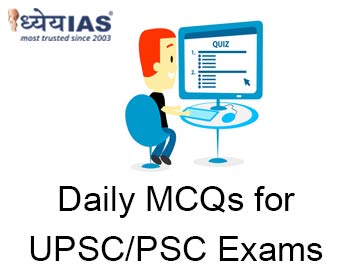Home > Daily-mcqs
Daily-mcqs 03 Sep 2025

Q1:
Consider the following statements regarding the Air Quality Life Index (AQLI): 1. It is developed by the World Health Organization (WHO). 2. AQLI quantifies the impact of PM2.5 pollution on human life expectancy. 3. The 2025 edition of AQLI is based on global data from the year 2023. Which of the statements given above is/are correct?
A: 1 and 2 only
B: 2 and 3 only
C: 1 and 3 only
D: 1, 2 and 3
Answer: B
Explanation:
Q2:
With reference to the Air Quality Life Index (AQLI) 2025, consider the following statements: 1. Air pollution is identified as the most severe health threat in India, reducing the average life expectancy by over 5 years. 2. According to the report, all of India’s population lives in areas exceeding the WHO’s PM2.5 guideline. 3. Delhi-NCR shows the highest potential life expectancy loss due to air pollution in India. 4. PM2.5 pollution is now the second-largest external risk to global life expectancy, after smoking. Which of the statements given above are correct?
A: 1 and 3 only
B: 2 and 4 only
C: 2 and 3 only
D: 1, 2 and 3 only
Answer: C
Explanation:
Statement 1: Incorrect
Statement 2: Correct
Statement 3: Correct
Statement 4: Incorrect
Q3:
With reference to CEREBO, recently launched in India, consider the following statements: 1. It is an invasive diagnostic tool for detecting Traumatic Brain Injuries (TBIs). 2. The device uses near-infrared spectroscopy and machine learning to detect intracranial bleeding and cerebral edema. 3. It does not requires advanced radiological infrastructure and trained radiologists for operation. 4. CEREBO is designed for use even in rural and emergency settings. Which of the statements given above is/are correct?
A: 1 and 2 only
B: 2 and 4 only
C: 1 ,3 and 4 only
D: 2, 3 and 4 only
Answer: D
Explanation:
Statement 1: Incorrect
Statement 2: Correct
Statement 3: correct
Statement 4: Correct
Q4:
With reference to Vikram 3201, consider the following statements: 1. Vikram 3201 is India’s first fully indigenous 32-bit microprocessor. 2. It is designed primarily for commercial applications such as smartphones and laptops. 3. The processor has been developed jointly by ISRO and the Semiconductor Laboratory (SCL), Chandigarh. Which of the statements given above are correct?
A: 1 and 3 only
B: 1, 2 and 3
C: 3 only
D: 2 only
Answer: A
Explanation:
Statement 1: Correct
Statement 2: Incorrect
Statement 3: Correct
It has been jointly developed by ISRO and the Semiconductor Laboratory (SCL), Chandigarh, a key facility under the Department of Space.
Q5:
With reference to semiconductors and the India Semiconductor Mission (ISM), consider the following statements: 1. Semiconductors are materials that can behave as both conductors and insulators. 2. The India Semiconductor Mission (ISM) was launched in 2021 with the aim of establishing a self-reliant semiconductor and display manufacturing ecosystem in India. 3. The Design-Linked Incentive (DLI) scheme under ISM focuses on promoting large-scale chip manufacturing facilities in India. 4. Semiconductors are crucial not only for consumer electronics but also for sectors like defense, space, and healthcare. Which of the statements given above are correct?
A: 1, 2 and 4 only
B: 1, 3 and 4 only
C: 2, 3 and 4 only
D: 1, 2, 3 and 4
Answer: A
Explanation:
Statement 1: Correct
Semiconductors have the unique property of behaving as both conductors and insulators, enabling precise control of electrical signals — this is why they are vital to electronic circuits.
Statement 2: Correct
The India Semiconductor Mission (ISM) was launched in December 2021 with a budget of ₹76,000 crore to create a self-reliant semiconductor and display ecosystem.
Statement 3: Incorrect
The Design-Linked Incentive (DLI) scheme under ISM does not promote large-scale manufacturing directly.
It is specifically aimed at supporting chip design, including ICs, SoCs, and other components — especially by startups and domestic companies.
Statement 4: Correct
Semiconductors are essential not just for smartphones and computers but also for defense systems, space technology, medical equipment, and more — forming the backbone of digital and automated systems.